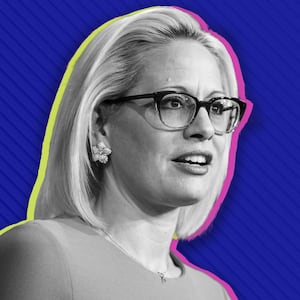PHOENIX—It was another 100-degree summer day in Arizona and Kyrsten Sinema couldn’t take the heat.
Arizona’s senior Democratic senator may not have been physically present as a group of progressive activists gathered in a downtown Phoenix park, demanding she do more to combat the existential threat of climate change.
But a representation of Sinema was there—a four-foot sculpture of her carved out of a big block of ice—to display at an event held by activists from the left-wing Working Families Party.
ADVERTISEMENT
And she was slowly melting.
Which was, of course, the point.
As speakers took turns pleading for Democratic leaders to take up a Green New Deal, the sculpture of Sinema dripped into a plastic basin in the back of a balmy indoor conference room. But the statue’s pose—an arm outstretched with a thumbs-down—was still intact, a reminder of her rejection of a plan to raise the federal minimum wage to $15 on the Senate floor earlier this year.
“She’s barely making it,” laughed one organizer walking by.
The layers of subtext behind the display are not hard to unpack. A melting ice statue, for one, is not an especially subtle metaphor for Washington’s efforts to slow climate change. And it’s a blunt symbol for the vanishing esteem within the base of the Democratic Party for centrist lawmakers like Sinema, who are seen as obstacles to the sweeping action required to tackle climate change and a number of other key issues.
But the actual, flesh-and-blood Sinema seems to be made of stronger stuff than her frozen likeness. And the attempts to pressure her back home, so far, haven’t fared much better than a block of ice in the desert heat.
Since Democrats took control of Washington in January, Sinema—a key swing vote in the evenly split Senate—has been the target of a number of progressive advocacy campaigns, backed by millions of dollars in TV and digital ads meant to galvanize calls and letters to her office.
In recent months, the senator has been flooded with calls to support voting rights legislation, labor organizing legislation, a $15 minimum wage, a multi-trillion dollar economic package, and most crucially, reforms to the filibuster, the Senate’s 60-vote threshold for passing bills. Since June, nearly 50 people have been arrested during protests at her Phoenix office, including the Rev. Jesse Jackson.
Through it all, Sinema hasn’t budged, especially on the filibuster. Arizona progressives not only feel that she isn’t listening to them—they are convinced she’s simply trolling them at this point.
“She doubles down,” said Matthew Marquez, an organizer with the Working Families Party, in a brief interview under the glare of the Sinema statue. “She’s very brazenly doubling down.”
For the local and national advocacy groups trying to pressure Sinema, demoralization is setting in as they worry time is running out to enact Democrats’ ambitious agenda while they control Washington.
There is deep anger, too, over Sinema’s perceived betrayal of the people who helped propel her to power in the first place.
“She sold us out,” said Channel Powe, a member of the Just Democracy Coalition, which has been bankrolling anti-Sinema TV ad campaigns.
“These are the same people who fought for you, walked in 110 degree heat door-knocking… she used us, flat out,” Powe said. “She used everybody to get to where she’s at. And now she’s high and mighty on her throne, and she’s not coming down to talk to us little people.”
In response to such claims, Sinema spokesperson John LaBombard said that “during three terms in the U.S. House, and now in the Senate, Kyrsten has always promised Arizonans she would be an independent voice for the state—not for either political party. She’s delivered on that promise and has always been honest about where she stands.”
But the sense has been simmering since Sinema came to the Senate in 2019. Even though she has acted like a Democrat who won a Senate seat by appearing allergic to being called a Democrat, it’s a long way from her roots as a Green Party activist who just a decade ago ridiculed centrist Democrats like former Sen. Joe Lieberman.
Progressives’ frustration hit a new level this March with Sinema’s vote on the $15 minimum wage—a vote that was made with a gesture seen by many as an exaggerated, almost breezy, thumbs down. And that anger boiled over when the senator, amid the backlash to that vote, posted a selfie on Instagram in late April, in which she wore a ring with a neat message in cursive: “Fuck off.”
Both moves were seen by liberals as middle fingers from Sinema—literal and figurative. Since, the narrative that she delights in trolling the left has taken hold in Arizona: in July, the editorial board of the Arizona Republic declared that Sinema has “cheekily provoked [liberals’] fury with thumbs-down and curtsies and ring fingers.”
Sinema’s office has not clarified the intent of these scrutinized moves, only arguing in March that any discussion of her fashion choices or body language is sexist.
Amid that confusion, there are glimmers that Sinema’s gestures had broader audiences than her left-wing detractors. The 19th News reported, for instance, that the thumbs-down seen around Twitter was perhaps a curtsy directed to overworked Senate floor staff.
And Sinema brandished the “Fuck off” ring on Instagram just as she was beefing with Arizona Gov. Doug Ducey for implementing a highly controversial plan to give more money to schools that got rid of masking requirements. Sinema called the policy “absurdly dangerous” and “anti-science.”
Still, liberals have found plenty of tangible moves to be mad at Sinema about. In June, Sinema wrote an op-ed in the Washington Post defending the filibuster on the same day that the GOP used the filibuster to block voting legislation that Sinema and nearly all Democrats support.
Sinema continues to oppose any changes to the filibuster, even a carve-out to pass voting legislation, which some fellow moderates have embraced. “Eliminating that threshold even to pass voting-rights legislation that she supports would open the door to that legislation being completely rescinded a few years from now and replaced by a nationwide voter-ID law or restrictions on vote-by-mail in federal elections, further undermining voting rights in every state across the nation,” said LaBombard, Sinema’s spokesperson.
It doesn’t help liberals’ case that Sinema is coming off a vindication of her vision of moderate governing. She played a leading role brokering a $1 trillion bipartisan infrastructure deal that attracted 19 GOP votes and inspired sentiment that the Senate was finally working again.
And immediately after that deal passed the Senate, Sinema made it clear she wasn’t done shaping the debate, issuing a statement expressing concern over the size and scope of the $3.5 trillion economic package championed by President Joe Biden. That missive caused an immediate headache for party leaders and heartburn for liberals who think the price tag should be far higher.
As the senator digs in, differing opinions are beginning to sprout about whether or not a pressure campaign, no matter how sustained and well-funded, could ever make a difference.
Parris Wallace, the Arizona organizing director for the Working Families Party, said progressives have an imperative to “remind the senator of why she’s there and who she needs to be delivering for.”
In her telling, Sinema’s defiant responses only inspire many activists to do even more.
“When we think about Democrats having majorities in both chambers, and for her quite frankly to tell us to fuck off, it makes us here on the ground work harder,” Wallace said in an interview. “For me, it motivates me to want to organize more community members and have that conversation, because she is blocking legislation that is honestly the most transformative we’ve seen since the New Deal.”
But other Arizona Democrats, like state Sen. Juan Mendez, have openly urged progressives to focus their energies elsewhere. Powe, who has observed Sinema operate for over a decade as an active member and past officer in the Maricopa County Democratic Party, told The Daily Beast that Sinema has clearly made her political calculation.
“Kyrsten is fierce, and she’ll do anything to win. If anything means transforming her values, that’s what has taken place,” she said.
“We’re going to have to pressure her, go through the process,” Powe added, “but she’s not gonna move.”
The irony behind the bad blood is that Arizona progressives once adored Sinema. After all, she used to be one of them; the 44-year old got her start in politics as a left-wing firebrand who rose during the antiwar movement of the Bush era, doing the kind of organizing work that young progressives are doing now against her. When Barack Obama and Democratic majorities swept into office in 2009, Sinema urged them to avoid the “false pressure to get to 60” in order to pass ambitious legislation.
Sinema’s roots in left-wing politics are central to her origin story and political brand. In that telling, when she discovered that bomb-throwing didn’t work in the Arizona legislature, she embraced a moderate approach centered on the idea that the only way to accomplish Democratic priorities was by building bipartisan consensus.
After her election to the U.S. House in 2012, Sinema began to cultivate that centrist brand, becoming a member of the Blue Dog Coalition and voting three times against electing Nancy Pelosi as party leader.
When she ran for Senate in 2018, she did not do so as a fire-breathing progressive, but those progressives canvassed, donated, and voted in support of her, anyway, in hopes of sending her to the Senate and turning traditionally red Arizona at least a shade of blue.
If Sinema is emulating the path of past Arizona mavericks—like the late GOP Sen. John McCain, whom she calls a mentor—then the frustrated pressure campaigns targeting her may give way to heated primary campaigns.
Not every activist is ready to concede the point, but some readily admit that their best remaining move is to use current advocacy to lay the groundwork for a Democrat to primary Sinema when she is up for re-election in 2024.
The prospect of a Democrat challenging Sinema already excites the rank-and-file activists, like Charlotte Bliss and Sue Baird, who do things like drive 45 minutes each way, every Tuesday morning, to protest outside Sinema’s Phoenix office.
On a recent one of those mornings, they were holding signs urging support of Democrats’ voting legislation as cars whizzed by. Both are retired residents of the city’s suburbs and are active members of their local chapter of Indivisible, the liberal group formed after Donald Trump’s election in 2016.
After Trump’s exit from office, many members took a break after four years of constant protests and calls and letter-writing, but Sinema is “the one that got us back out,” said Bliss.
“We are all just so fed up because she would not be in frickin’ office if it weren’t for us,” she added. “I think she thinks we’re going to forget.”
It’s that kind of sentiment that puts Sinema in a different category than her fellow swing vote and centrist ally, Sen. Joe Manchin (D-WV).
In deep-red West Virginia, Manchin has won by courting independents and Republicans. Progressives know that primarying him would all but ensure Republicans flip the seat. As a result, they give Manchin more political space to maneuver, even if he’s subjected to similar pressure campaigns from mostly out-of-state activists.
Arizona, on the other hand, is at least trending purple: Biden won the state in 2020, as did Democratic Sen. Mark Kelly, a victory that gave Arizona two Democratic senators for the first time since the 1950s. To progressives, that means Sinema’s gestures toward the center and the right are no longer a political necessity—and that she cannot afford to alienate the growing bloc of liberal voters that propelled her to victory in 2018.
Public opinion polling on Sinema has been scant, given she is not up for re-election, and the political environment will surely shift by the 2024 election cycle. Still, a handful of surveys conducted this year don’t offer particularly promising signs for her.
A March poll by Arizona firm OH Predictive Insights found just 50 percent of Democrats viewed Sinema favorably, with 30 percent viewing her unfavorably. By comparison, 79 percent had a favorable opinion of Kelly, and only 11 percent had an unfavorable opinion. A July poll from the progressive polling firm Data For Progress found a similar dynamic at play.
Some Arizona liberals, like Baird, remain skeptical that a progressive Democrat could win statewide—she quipped that the state is “blue on the outside, red on the inside.” And that’s one reason to be cautious of how far Sinema could really be moved. “We were talking and saying, we're getting a little discouraged here,” Baird said.
Despite the signs to the contrary, other activists remain hopeful that there might be changes yet in store for a politician who’s shown a willingness to do what it takes in order to survive.
“On paper, she’s great. Her backstory is great. It reads super dreamy. In practice, it’s been a nightmare,” said the Working Families Party’s Wallace. “And so, I think what we need from her is to remember where she started from, and to quite honestly come home, and remember, to go back to the Sinema that’s on paper.”








